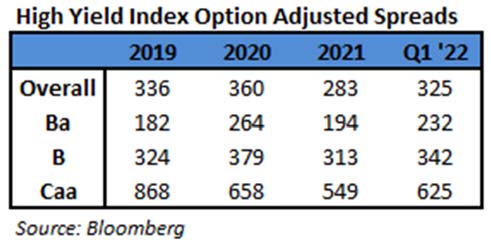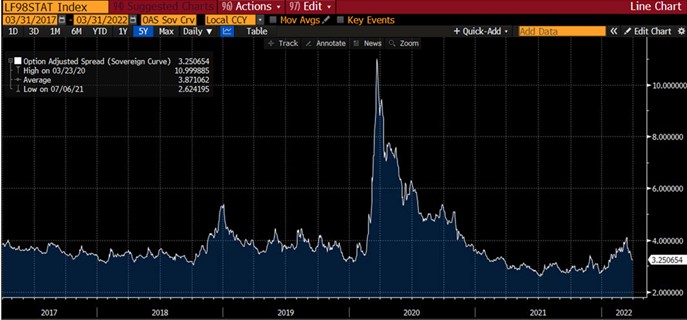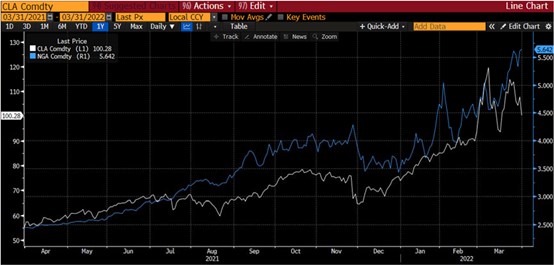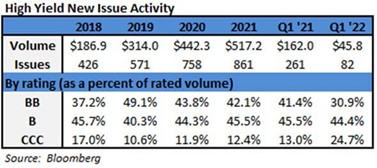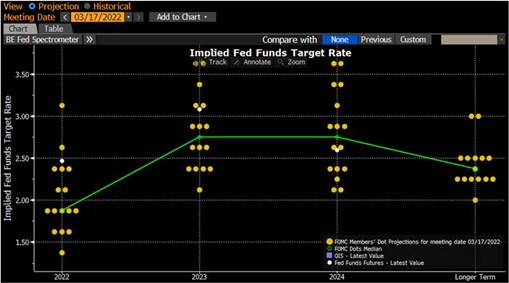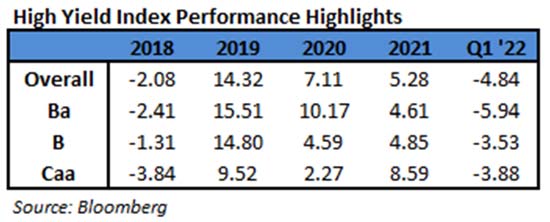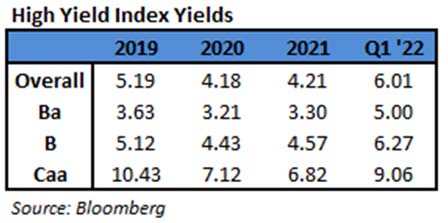2022 Q1 High Yield Quarterly
In the first quarter of 2022, the Bloomberg Barclays US Corporate High Yield Index (“Index”) return was ‐4.84% while the CAM High Yield Composite net of fees total return was ‐ 6.11%. The S&P 500 stock index return was ‐4.60% (including dividends reinvested) over the same period. The 10 year US Treasury rate (“10 year”) had a steady upward move as the rate finished at 2.34%, up 0.83% from the beginning of the quarter. During the quarter, the Index option adjusted spread (“OAS”) widened 42 basis points moving from 283 basis points to 325 basis points. Each quality segment of the High Yield Market participated in the spread widening as BB rated securities widened 38 basis points, B rated securities widened 29 basis points, and CCC rated securities widened 76 basis points. Take a look at the chart below from Bloomberg to see a visual of the spread moves in the Index over the past five years.
The Energy, Other Financial, and REITs sectors were the best performers during the quarter, posting returns of ‐2.54%, ‐2.73%, and ‐3.82%, respectively. On the other hand, Banking, Communications, and Utilities were the worst performing sectors, posting returns of ‐7.27%, ‐6.54%, and ‐5.71%, respectively. Clearly the market was weak as all sectors posted a negative return in the period. At the industry level, oil field services, independent energy, and leisure all posted the best returns. The oil field services industry posted the highest return 3.05%. The lowest performing industries during the quarter were wireless, food and beverage, and banking. The wireless industry posted the lowest return ‐11.79%.
The energy sector has been quite topical. Crude oil had a $45 per barrel range in Q1 and averaged $92 per barrel. Meanwhile, the natural gas market also moved steadily higher during the quarter reaching highs not seen in nine years. OPEC+ members are “refusing to deviate from their schedule of gradual production increases.”i They are also refusing to discuss the Russia‐Ukraine conflict with the last few meetings lasting less than fifteen minutes. Russia is a significant member of the broader group. Therefore, there likely needs to be much more political wrangling before the group takes a stand against one of their own.
During the first quarter, the high yield primary market finally took a break after three years of strong issuance. The weak market led by rising rates kept companies on the sidelines as only $45.8 billion posted in the quarter. Consumer Discretionary did continue to lead and took 33% of the market share. Second place was Materials at 12% of the total. Wall Street strategists have begun to lower their full year issuance forecasts. However, there isn’t much concern for lack of capital access due to issuers being so proactive with refinancing in the past few years.
The Federal Reserve did lift the Target Rate by 0.25% at their March meeting. That was the first increase since 2018. The chart to the left shows the updated Fed dot plot post the March meeting. Of note, the Fed median Target Rate for 2022 increased from 0.875 to 1.875. Such movement is a clear indication of the dynamic economic backdrop. Furthering the point, Fed Chair Jerome Powell commented just days after the March meeting, “If we conclude that it is appropriate to move more aggressively by raising the federal funds rate by more than 25 basis points at a meeting or meetings, we will do so.”ii He then went on to say, “And if we determine that we need to tighten beyond common measures of neutral and into a more restrictive stance, we will do that as well.” These moves are being driven by a tight employment market and inflation that is running higher than any point in the last 40 years. The Fed is undoubtedly looking to bring inflation lower while keeping the economy at some sustainable growth rate.
Intermediate Treasuries increased 83 basis points over the quarter, as the 10‐year Treasury yield was at 1.51% on December 31st, and 2.34% at the end of the first quarter. The 5‐year Treasury increased 120 basis points over the quarter, moving from 1.26% on December 31st, to 2.46% at the end of the first quarter. Intermediate term yields more often reflect GDP and expectations for future economic growth and inflation rather than actions taken by the FOMC to adjust the Target Rate. The revised fourth quarter GDP print was 6.9% (quarter over quarter annualized rate). Looking forward, the current consensus view of economists suggests a GDP for 2022 around 3.4% with inflation expectations around 6.2%.iii Worth mentioning is the yield curve inverting for the first time since 2019. Historically, inversion is an indication of pessimism in the growth outlook and concern of a nearing recession. The recent reports have been split between “the sky is falling” and “this time is different,” neither of which seems all that compelling at the present moment. Perhaps a more appropriate view is one attributed to Barclays. They suggest looking at the current environment in terms of recession probabilities. Based on their model, recession probabilities are not elevated coming in at roughly 20%. This is leading them to currently have the view that inflation is likely to brake rather than break the growth outlook.
Being a more conservative asset manager, Cincinnati Asset Management Inc. does not buy CCC and lower rated securities. This policy generally served our clients well in 2020. However, the lowest rated segment of the market outperformed during 2021. Thus, our higher quality orientation was not optimal last year.
That higher quality focus continued to have a tough time against the rising rate environment during Q1, as it is the most rate sensitive group within the broader high yield market. As a result and noted above, our High Yield Composite net of fees total return did underperform the Index in Q1. The higher quality positioning was the sizeable negative contributor relative to the Index, slightly offset by the cash position in an overall negative total return market.
The Bloomberg Barclays US Corporate High Yield Index ended the first quarter with a yield of 6.01%. The market yield is an average that is barbelled by the CCC rated cohort yielding 9.06% and a BB rated slice yielding 5.00%. Equity volatility, as measured by the Chicago Board Options Exchange Volatility Index (“VIX”), had an average of 25 over the quarter with a spike to a high of 36 as the market sold off during the first two and a half months of the year.
For context, the average was 15 over the course of 2019, 29 for 2020, and 19 for 2021. The first quarter had two bond issuers default on their debt. The trailing twelve month default rate fell to 0.23%. The current default rate is relative to the 4.80%, 1.63%, 0.92%, 0.27% default rates from the previous four quarter end data points listed oldest to most recent. The fundamentals of high yield companies are in great shape as leverage, profit margins, and debt servicing all look good. From a technical view, fund flows were negative in all three months of the quarter. The 2022 year‐to‐date outflow stands at $28.5 billion.iv Without question there has been a fair amount of damage in bond markets so far this year. It is important to remember that bonds are a contractual agreement with a defined maturity date. Thus, despite any price volatility, without default, par will be paid at the stated maturity date. Currently, defaults are at historic lows and fundamentals are at highs. Further, as the quarter closed, the market saw a weekly inflow, only the second of the year. Additionally, market returns coincidently bottomed just as the Fed started raising rates. That seems interesting to say the least. Naturally, we are of the belief that for clients that have an investment horizon over a complete market cycle, high yield deserves to be considered as part of the portfolio allocation.
The backdrop as we move into the second quarter of 2022 is quite intriguing. Inflation is at four decade highs, the yield curve is inverting, recession fears are bubbling, supply chain disruptions are ongoing, energy markets are heading skyward, the Federal Reserve is starting a hiking cycle, and there is a war that has the attention of the entire world. But, the market just had the biggest weekly gain in over fifteen months, rising stars are at a record pace, companies are in solid financial shape, and default rates are extremely low. Clearly, it is important that we exercise discipline and selectivity in our credit choices moving forward. We are very much on the lookout for any pitfalls as well as opportunities for our clients. We will continue to carefully monitor the market to evaluate that the given compensation for the perceived level of risk remains appropriate on a security by security basis. As always, we will continue our search for value and adjust positions as we uncover compelling situations. Finally, we are very grateful for the trust placed in our team to manage your capital.
This information is intended solely to report on investment strategies identified by Cincinnati Asset Management. Opinions and estimates offered constitute our judgment and are subject to change without notice, as are statements of financial market trends, which are based on current market conditions. This material is not intended as an offer or solicitation to buy, hold or sell any financial instrument. Fixed income securities may be sensitive to prevailing interest rates. When rates rise the value generally declines. Past performance is not a guarantee of future results. Gross of advisory fee performance does not reflect the deduction of investment advisory fees. Our advisory fees are disclosed in Form ADV Part 2A. Accounts managed through brokerage firm programs usually will include additional fees. Returns are calculated monthly in U.S. dollars and include reinvestment of dividends and interest. The index is unmanaged and does not take into account fees, expenses, and transaction costs. It is shown for comparative purposes and is based on information generally available to the public from sources believed to be reliable. No representation is made to its accuracy or completeness.
i Bloomberg March 31, 2022: OPEC+ Stands Back as Oil Consumers Move to Ease Prices
ii Bloomberg March 22, 2022: Powell Is Ready to Back Half‐Point Hike
iii Bloomberg April 4, 2022: Economic Forecasts (ECFC)
iv Wells Fargo March 31, 2022: “Credit Flows”
